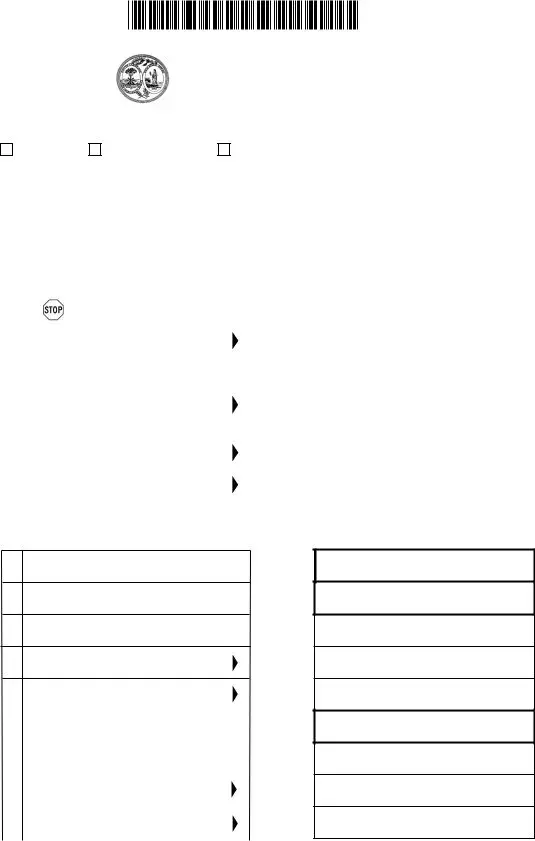The State of South Carolina ST-455 form, designed for the calculation and reporting of state sales, use, and maximum taxes, bears resemblance to a variety of other tax-related documents tailored to distinct purposes or jurisdictions. One such document is the State of North Carolina E-500, which serves as the Sales and Use Tax Return. Both forms share the intrinsic goal of collecting tax owed on sales, rentals, and purchases made within the respective states. They require detailed information about gross sales, applicable deductions, and the net taxable amount, structuring this data to facilitate accurate tax calculation and compliance with state laws.
Similar yet not identical, the California State Board of Equalization's Sales and Use Tax Return mirrors the South Carolina ST-445 form in function and intent. Offering a platform for businesses to report and remit taxes on sales and purchases, this document emphasizes the importance of understanding local jurisdictional tax rates, much like the ST-455's attention to distinctions between general and specific taxable items. California's form additionally mandates information on district taxes, echoing the complexity faced by filers of the ST-455 grappling with local taxes due.
The New York State Department of Taxation and Finance's ST-810 form, utilized for quarterly sales and use tax filings by vendors, aligns with the ST-455's structure regarding the reporting of gross sales, deductions, and net taxes due. Both documents underscore the critical nature of timely, accurate tax reporting for businesses, ensuring municipal and state governments receive necessary revenues to fund public services. The emphasis on detail, accounting for taxable and exempt transactions, showcases the documents’ roles in maintaining tax system integrity.
Florida's Discretionary Sales Surtax Information (Form DR-15DSS), although focusing primarily on the surtax aspect, complements the essence of South Carolina's ST-455 by addressing sales and use tax obligations at a more localized level. It highlights the variations in tax rates across counties, akin to the ST-455's accommodation for local tax calculations. Each form educates filers on jurisdiction-specific requirements, guiding businesses through the nuanced landscape of state and local taxation.
Similarly, the Texas Sales and Use Tax Return (Form 01-114) provides a comprehensive framework for reporting state, city, county, and special jurisdiction taxes, akin to the multifaceted approach of the ST-455. Both forms expect businesses to dissect their sales and transactions meticulously, applying different tax rates where applicable to comply with a layered tax structure. This detailed reporting ensures accurate allocation of tax revenues to various governing entities.
Another counterpart is the Illinois Sales and Use Tax Return (Form ST-1), dedicated to capturing a wide array of taxable transactions within the state. Like the ST-455, it requests detailed breakdowns of sales, deductions, and taxes due, catering to a broad spectrum of sales and use tax scenarios. Both documents facilitate the state's efforts to collect taxes effectively, thereby supporting essential public services, from infrastructure to education.
The Ohio Sales and Use Tax Return (Form UST-1) demonstrates another example of a state-specific approach to tax collection, mirroring the ST-455’s comprehensive nature. It outlines the necessity for businesses to calculate and report taxes accrued from sales and services, adjusting for various exemptions and tax brackets. This form, akin to South Carolina's, serves as a crucial tool in upholding the state's fiscal responsibilities.
Pennsylvania's Sales and Use Tax Return (PA-3) shares the objective of detailing transactions subject to sales and use taxes. It mandates the accounting of taxable sales, permissible deductions, and the calculation of net taxes in a manner that parallels the ST-455. The emphasis on accurate, detailed reporting underscores both forms' roles in ensuring compliance with state tax laws and supporting government operations through generated revenues.
Michigan's Sales, Use, and Withholding Taxes Monthly/Quarterly Return (Form 5080), although encompassing withholding taxes in addition to sales and use taxes, presents a comprehensive approach similar to the ST-455. By requiring detailed transactional data and accommodating various tax rates, it ensures businesses contribute correctly to state coffers. This multipurpose nature reflects the complex landscape of state tax administration.
Lastly, the Virginia Sales and Use Tax Return (Form ST-9) offers a close comparison in its requirement for sellers to report gross sales, deductions, and calculate taxes due. Both this form and the ST-455 guide businesses through the nuances of tax compliance, highlighting exempt sales and the impact of local tax rates. Through this detailed reporting, both forms play a vital role in sustaining public services via tax revenue.


